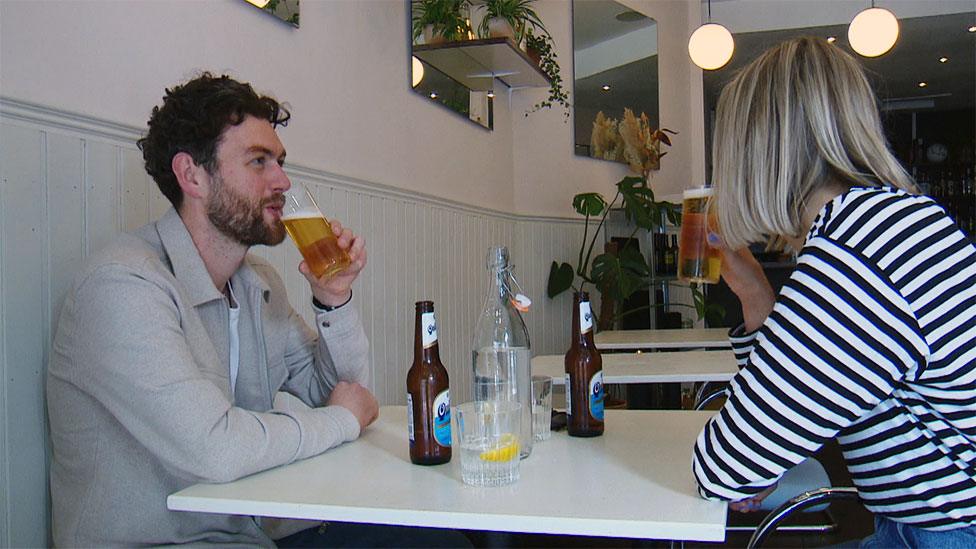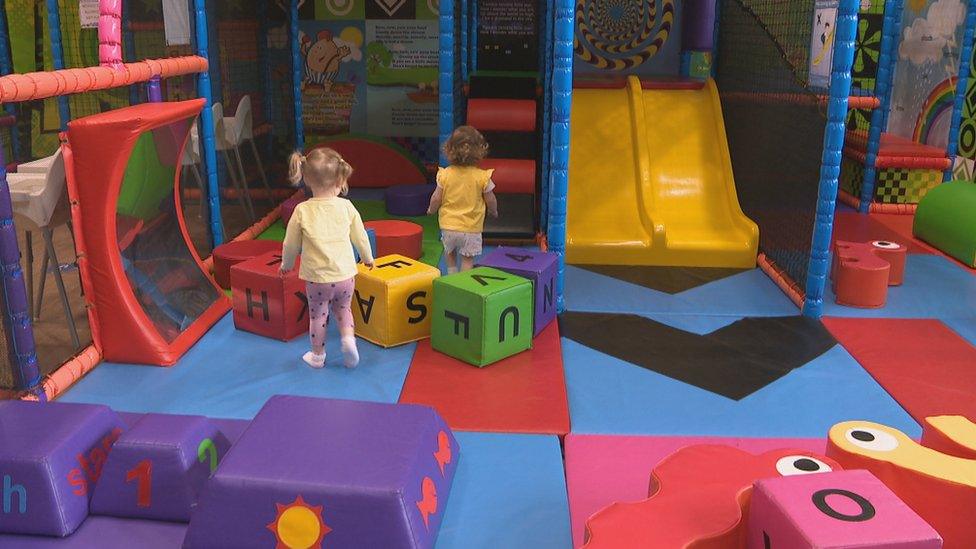Covid in Scotland: Restriction levels ease for millions of Scots
- Published

Millions of people in Scotland have moved into lower restriction levels, allowing them to meet in larger groups indoors and outside.
In Glasgow people are allowed to meet in each other's homes for the first time in nine months, and to drink alcohol in pub and restaurants.
Other areas of the mainland are seeing soft play centres open for the first time in more than a year.
But restrictions on many of Scotland's islands are nearest "normality".
Orkney, Shetland and the Western Isles have moved into level zero - the lowest of the Scottish government's five tier system for exiting lockdown.
Fourteen council areas in the north and south of mainland Scotland moved from level two to level one at midnight.
However 13 areas with a combined population of 2.3million in the central belt remain in level two, rather than moving down to level one as planned due to high case numbers.
The whole country is due to move to level zero on 28 June but the prevalence of the Delta variant, first detected in India, may delay that.
Infections have more than tripled in the past month with Friday's 992 new cases being the highest figure reported since 17 February. There were 860 new cases reported on Saturday.
Scotland's national clinical director Prof Jason Leitch said public health advisors were "little bit worried" and the country had to be "cautious" in its route out of lockdown.

Danny Whelan and Fiona Griffin were among the first to enjoy a drink indoors at Flùr in Glasgow's Partick
In Glasgow, where residents and businesses have faced the toughest restrictions in Scotland for almost nine months, pubs and restaurants are opening later in the evenings and serving alcohol indoors again.
Steve Aitken of Flùr in Partick told BBC Scotland of his relief at being able to finally allow customers to drink alcohol inside.
"There's been a lot of ups and downs, a lot of times when we've felt like chucking it but now we've finally got the doors open, we've got some people inside, it's going to be amazing," he said.
The bar operated as a takeaway/bottle shop during lockdown but now he is hopeful for the future.
"Probably the biggest worry is another spike and another lockdown but hopefully with the vaccine and everyone playing the game, we won't have that," he added.
Customer Danny Whelen said: "It feels like a lifetime ago the last time we could be indoors and enjoying drinks. I'm delighted - happy to be back."

For some children it was their first time at soft play in Inverclyde
Bob McVitie, of Inverclyde Leisure, said it was great to welcome back staff and customers to soft play for the first time in 440 days after the region moved to level one.
"I think it all gives us a little bit of hope that lockdown's easing and there's a bright future ahead," he said.
Customer Monica Miller said it was the first time her young son, Blair, had been to the facility.
"It's wonderful experience... a small bit of normality back into life for us, to let him be among other kids, run about and have a bit of freedom."

What level of Covid restrictions is my area in?

Scotland's councils will be in the following levels from Saturday:
Level two - Glasgow, Edinburgh, Midlothian, Dundee, East Dunbartonshire, Renfrewshire, East Renfrewshire, North Ayrshire, South Ayrshire, East Ayrshire, North Lanarkshire, South Lanarkshire, Clackmannanshire, and Stirling
Level one - Highland, Argyll and Bute, Aberdeen City, Aberdeenshire, Moray, Angus, Perth and Kinross, Falkirk, Fife, Inverclyde, East Lothian, West Lothian, West Dunbartonshire, Dumfries and Galloway, and the Borders
Level zero - Shetland, Orkney, the Western Isles, and a number of smaller islands

Meanwhile in Orkney the move to level zero means up to 10 people from four households can meet in a cafe, pub or restaurant.
Raymond Hutchison, from the St Ola Hotel in Kirkwall, said it was a welcome boost to businesses on the islands.
He told BBC Scotland: "What's more exciting for me is that we've got into level zero now at the start of June.
"So does that mean we can get to the next level, which is what we need, as early as the end of the month? That would be fantastic."

Raymond Hutchison said the further easing of restrictions at the beginning of the summer was good timing for businesses in Orkney
But the leader of Orkney Islands Council, James Stockan, also urged caution as increasing numbers of tourists visit the islands over the summer.
"It's the direction of travel that's really important. At the same time we've got to be very conscious that we have more and more people coming here," he told the BBC.
"We're really asking them to take a lateral flow test - and even our own community going away and coming back again. Just taking those tests to give us an extra degree of safety."


Outside the central belt most of the mainland now faces level one restrictions.
The change to personal freedoms which comes from a move down from level two is not dramatic, but it does change the mood. The knowledge that it is possible to meet more friends and family members can lift spirits.
In Campbeltown this morning, for instance, the atmosphere seems much more relaxed almost - for want of a better phrase - normal.
Customers in shops still have to wear masks, of course, while cafes still have to take details from diners.
But mainland Argyll and Bute now has lighter restrictions than at any time since March 2020.
In much of rural Scotland tourism is hugely important to the economy and the stakes will be high for many businesses.
But in some rural areas there is a little nervousness too.
Often these areas have had very low Covid rates all through the crisis. Some local people may be worried that reopening travel risks a rise in case numbers - despite optimism that vaccination is breaking the link between cases and serious illnesses.
That perhaps serves as a reminder to visitors to follow the rules and be mindful that some local people, who may seem like they are being over-vigilant, might be a little worried.
After so long, finding a form of normal is about more than the legal easing of restrictions.


